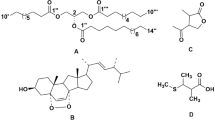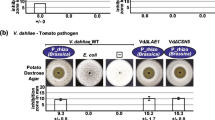Abstract
A mycelial suspension of Nectria haematococca completely demethylated 0.1 mM pisatin in 2 h in a medium free of other carbon sources while no demethylation of pisatin by the fungus occurred in 6 h when 2% glucose was in the medium. Prior exposure of the fungal cells to pisatin in glucosefree medium markedly enhanced the rate of pisatin demethylation, with maximum stimulation occurring 5–9h after the initial exposure. The stimulation of pisatin demethylating ability was relatively specific for pisatin as the inducer. Out of a large variety of isoflavonoids tested the only compounds other than pisatin that stimulated the activity significantly were pterocarpan or isoflavan derivatives. Protoplasts with pisatin demethylating ability were isolated from pisatin-treated mycelium. Attempts to obtain a cell-free system with pisatin demethylating ability from these protoplasts were unsuccessful.
Similar content being viewed by others
References
Anné J, Eyssen H, De Somer P (1974) Formation and regeneration of Penicillium chrysogenum protoplasts. Arch Microbiol 98:159–166
Barz W (1971) Über den Abbau aromatischer Verbindungen durch Fusarium oxysporum Schlecht. Arch Microbiol 78:341–352
Barz W, Schlepphorst R, Laimer J (1976) Über den Abbau von Polyphenolen durch Pilze der Gattung Fusarium. Phytochemistry 15:87–90
Bernhardt F, Pachowsky H, Staudinger H (1975) A 4-Methoxybenzoate O-demethylase from Pseudomonas putida. A new type of monooxygenase system. Eur J Biochem 57:241–256
DeWit-Elshove A, Fuchs A (1971) The influence of the carbohydrate source on pisatin breakdown by fungi pathogenic to pea (Pisum sativum). Physiol Plant Pathol 1:17–24
Fleischer S, Packer L (eds) (1978) Methods in enzymology. Vol III Biomembranes. Part C: Biological oxidations: Microsomal Cytochrome P-450, and other hemoprotein systems. Academic Press New York San Francisco London
Fuchs A, DeVries W, Platero Sanz M (1980) The mechanism of pisatin degradation by Fusarium oxysporum f. sp. pisi. Physiol Plant Pathol 16:119–133
Hayaishi O (ed) (1974) Molecular mechanisms of oxygen activation. Academic Press, New York London
Lappe U, Barz W (1978) Degradation of pisatin by fungi of the genus Fusarium. Z Naturforsch 33c:301–302
Pachler KGR, Underwood WGE (1967) A proton magnetic resonance study of some pterocarpan derivatives. The conformation of the 6a,11a-dihydro-6-H-benzofuro[3,2-c][1] benzopyran ring system. Tetrahedron 23:1817–1826
Paulson GD, Frear DS, Marks EP (eds) (1979) Xenobiotic Metabolism: In vitro methods. ACS Symposium series 97. American Chemical Society. Washington DC
Perrin DR, Bottomley W (1962) Studies on phytoalexins. V. The structure of pisatin from Pisum sativum I J American Chemical Soc 84:1919–1922
Perrin DR, Cruickshank IAM (1969) The antifungal activity of pterocarpans towards Monilinia fructicola. Phytochemistry 8:971–978
Platero Sanz MP, Fuchs A (1978) Degradación de pisatina, un compuesto antimicrobiano producido por Pisum sativum L. Phytopathol Mediterr 17:14–17
Poland A, Glover E (1977) Chlorinated biphenyl induction of aryl hydrocarbon hydroxylase activity: a study of the structure-activity relationship. Mol Pharmacol 13:924–938
Pueppke SG, VanEtten HD (1975) Identification of three new pterocarpans (6a, 11a-dihydro-6H-benzofuro[3,2-c] [1] benzopyrans) from Pisum sativum infected with Fusarium solani f sp. pisi. J Chem Soc, Perkin Trans. 1:946–948
Smith RV, Davis PJ (1980) Induction of xenobiotic monooxygenases. In: Fiechter A (ed) Advances in biochemical engineering. Vol 14. Springer Berlin Heidelberg New York, pp 61–100
Testa B, Jenner P (1976) Drug metabolism: Chemical and biochemical aspects, Marcel Dekker, Inc New York Basel
VanEtten HD (1976) Antifungal activity of pterocarpans and other selected isoflavonoids. Phytochemistry 15:655–659
VanEtten HD (1978) Identification of additional habitats of Nectria haematococca mating population VI. Phytopathology 68:1552–1556
VanEtten, HD, Pueppke SG, Kelsey TC (1975) 3,6a-Dihydroxy-8,9-methylenedioxypterocarpan as a metabolite of pisatin produced by Fusarium solani f. sp. pisi. Phytochemistry 14:1103–1105
VanEtten HD, Matthews PS, Tegtmeier KJ, Dietert MF, Stein JI (1980) The association of pisatin tolerance and demethylation with virulence on pea in Nectria haematococca. Physiol Plant Pathol 16:257–268
Weltring KM, Barz W (1980) Degradation of 3,9-dimethoxypterocarpan and medicarpin by Fusarium proliferatum. Z Naturforsch 35c:399–405
Wong E (1970) Structural and biogenetic relationships of isoflavonoids. Fortsch Chem Org Naturst 28:1–73
Author information
Authors and Affiliations
Rights and permissions
About this article
Cite this article
Van Etten, H.D., Barz, W. Expression of pisatin demethylating ability in Nectria haematococca . Arch. Microbiol. 129, 56–60 (1981). https://doi.org/10.1007/BF00417181
Received:
Issue Date:
DOI: https://doi.org/10.1007/BF00417181




